동종요법 창시자, 독일의 의사 하네만 (Christian Friedrich Samuel Hahnemann, 1755 ~ 1843)
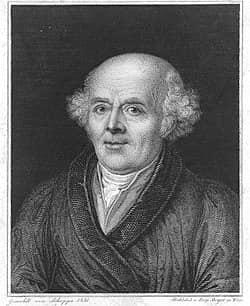
C. F. S 하네만 (Christian Friedrich Samuel Hahnemann, 1755년 4월 10일 ~ 1843년 7월 2일)은 독일의 의사로 호뫼오파티의 창시자다. 주요저서인 ‘약물학’ (1811)은 호뫼오파티의 기초 문헌이다.
독일 작센주 (州) 마이센 출생이다. 호뫼오파티 (Homöopathie : 類似療法)의 창시자로서 1779년 에를랑겐대학을 졸업, 1789년 라이프치히에서 개업하였다. W. 컬런의 ‘약물학에 관한 강의 : Lectures on the Materia Medica’를 독일어로 번역하고 있을 때, 퀴닌을 건강인 (健康人)에게 투여 (投與)하게 되면, 그 사람에게 퀴닌에 의한 치료를 필요로 하는 환자가 나타내는 증상과 동일한 증상이 나타난다는 사실을 알게 되어, 마침내 호뫼오파티 요법을 착상하게 되었다 (1796). 1834년 프랑스 파리로 이주하여 진료를 계속하였다. 주요저서인 ‘약물학 : Reine Arzneimittellehre’ (1811)은 호뫼오파티의 기초 문헌이다.
– C. F. S 하네만 (Christian Friedrich Samuel Hahnemann)
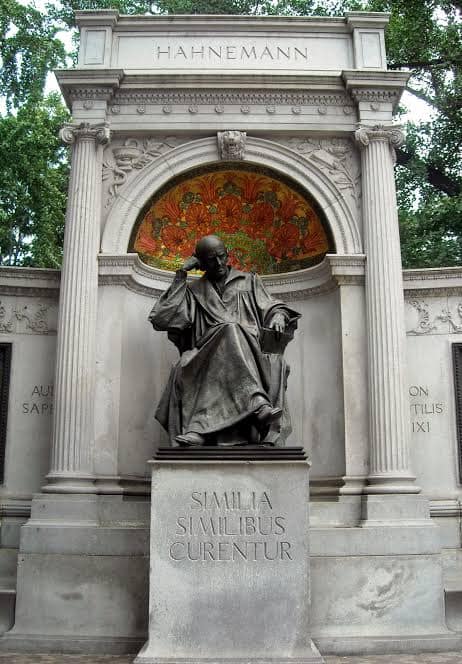
.출생: 1755년 4월 10일, 독일 마이센
.사망: 1843년 7월 2일, 프랑스 파리
.본명: Christian Friedrich Samuel Hahnemann
.배우자: 멜라니 하네만 (1835년–1843년)
.국적: 독일, 프랑스
하네만 (Christian Friedrich Samuel Hahnemann, 1755 ~1843)은 독일의 의사로 ‘동종요법’ (Homöopathie)이라고 알려진 치료체계를 확립했다.
하네만은 라이프치히와 빈에서 의학을 공부했고 1779년 에를랑겐대학교에서 의사자격을 획득했다. 여러 곳을 다니며 진료한 뒤 1784년 드레스덴에 정착했다가 1789년 라이프치히로 이사했다. 그 다음해 윌리엄 컬런의 ‘약물학 강의 : Lectures on the Materia medica’를 독일어로 번역하는 동안 하네만은 퀴닌이 건강한 신체에 일으키는 증상과 치료하기 위해 퀴닌을 사용하는 질환의 증상이 유사하다는 사실에 주목하게 되었다. 이러한 관찰을 통해 그는 “비슷한 것은 비슷한 것에 의해 치료된다”, 즉 질병은 그 질병과 유사한 증상을 일으키는 약에 의해 치료된다고 주장했다.
하네만은 이 원리를 1796년에 출간된 한 논문에서 발표했고, 4년 후에는 그러한 약물을 소량 복용하면 치료효과가 있다고 확신하여 이들 약물의 ‘역동화의 효력화’ (potentization of dynamization) 원리를 발전시켰다. 그의 주요저작인 ‘합리적 의학의 원칙 Organon der rationellen Heilkunst’ (1810)에는 그가 동종요법이라고 명명한 원리를 자세히 설명하고 있다. 또한 그의 ‘순수 약리학 : Reine Arzneimittellehre’ (6권, 1811)에는 많은 약물을 건강한 사람에게 체계적으로 투여하여 ‘증명된’ 증상들을 자세히 기술했다. 1821년 그에 대한 약종상들의 적의 때문에 라이프치히를 떠나야만 했는데, 안할트-쾨텐 대공이 초청해 쾨텐으로 이사했다. 그는 14년 후 파리로 이사해 그곳에서 죽을 때까지 상당한 인기를 누리며 진료했다.
○ 동종요법 (同種療法, homeopathy)
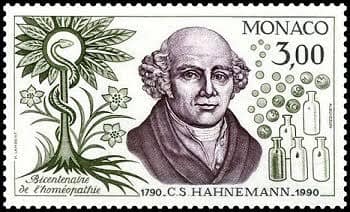
18세기 후반 독일의 의사 사무엘 하네만 (Samuel Hahnemann)이 창시한 대체 의학으로, 쉽게 말하면 “같은 것이 같은 것을 치료한다”는 믿음으로 하는 치료이다.
영어 어원에서 homo= 같은 이라는 의미를 가지고 있다. pathy는 감정, 혹은 치료라는 의미이다.
“같은 것이 같은 것을 치료한다”는 의미는 예를 들면 통증을 치료 할 때에는 통증을 유발하는 물질을 섭취하면 통증이 좋아진다고 주장한다.
이때 통증 유발 물질은 실제로는 그 성분이 없어 질 정도까지 계속 희석해서 사용한다고 주장한다. 여기에서 나온 것이 물치료 요법이다.

현재 가장 활발하게 사용되는 국가는 인도로 7천 개의 병원에서 의사 24만6천 명이 시행하고 있다.
한편 2007년 미국에서 시장 규모는 27억 달러, 영국에서 2012년의 시장규모는 4600만 파운드로 추정된다.
원래 영국에서는 국가 의료보험도 적용되었으나 2010년부터 제외되었다.
원조인 독일에서도 2004년에 제외되었다.
스위스에서는 2012년, 프랑스에서 2021년부터 적용이 중지된다.
○ 저작들
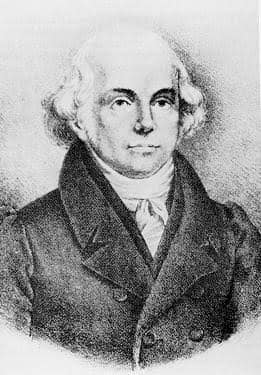
Hahnemann wrote a number of books, essays, and letters on the homeopathic method, chemistry, and general medicine:
Heilkunde der Erfahrung. Norderstedt 2010.
Versuch über ein neues Prinzip zur Auffindung der Heilkräfte der Arzneisubstanzen, nebst einigen Blicken auf die bisherigen [Essay on a New Principle for Ascertaining the Curative Powers of Drugs] (in German). 1796. reprinted in Versuch über ein neues Prinzip zur Auffindung der Heilkräfte der Arzneisubstanzen, nebst einigen Blicken auf die bisherigen. Haug. 1988.
Fragmenta de viribus medicamentorum positivis sive in sano corpore humano obeservitis, a collection of 27 drug “provings” published in Latin in 1805.
The Organon of the Healing Art (1810), a detailed delineation of what he saw as the rationale underpinning homeopathic medicine, and guidelines for practice. Hahnemann published the 5th edition in 1833; a revised draft of this (1842) was discovered after Hahnemann’s death and finally published as the 6th edition in 1921.
Materia Medica Pura, a compilation of “homoeopathic proving” reports, published in six volumes between vol. I in 1811 and vol. VI in 1827. Revised editions of volumes I and II were published in 1830 and 1833, respectively.
Chronic Diseases (1828), an explanation of the root and cure of chronic disease according to the theory of miasms, together with a compilation of “homoeopathic proving” reports, published in five volumes during the 1830s.
The Friend of Health, in which Hahnemann “recommended the use of fresh air, bed rest, proper diet, sunshine, public hygiene and numerous other beneficial measures at a time when many other physicians considered them of no value.”

Appeal to Thinking Philanthropist Respecting the Mode of Propagation of the Asiatic Choler, in which Hahnemann describes cholera physicians and nurses as the “certain and frequent propagators” of cholera and that whilst deriding nurses’ “fumigations with chlorine”, promoted the use of “drops of camphorated spirit” as a cure for the disease.
Hahnemann also campaigned for the humane treatment of the insane in 1792.
John Henry Clarke wrote that “In 1787, Hahnemann discovered the best test for arsenic and other poisons in wine, having pointed out the unreliable nature of the ‘Wurtemberg test,’ which had been in use up to that date.”
Samuel Hahnemanns Apothekerlexikon . Vol.2 . Crusius, Leipzig 1798–1799 Digital edition by the University and State Library Düsseldorf.
Reine Arzneimittellehre . Arnold, Dresden (several editions) 1822–1827 Digital edition by the University and State Library Düsseldorf.
Systematische Darstellung der reinen Arzneiwirkungen aller bisher geprüften Mittel . Vieweg, Braunschweig 1831 – Digital edition by the University and State Library Düsseldorf.
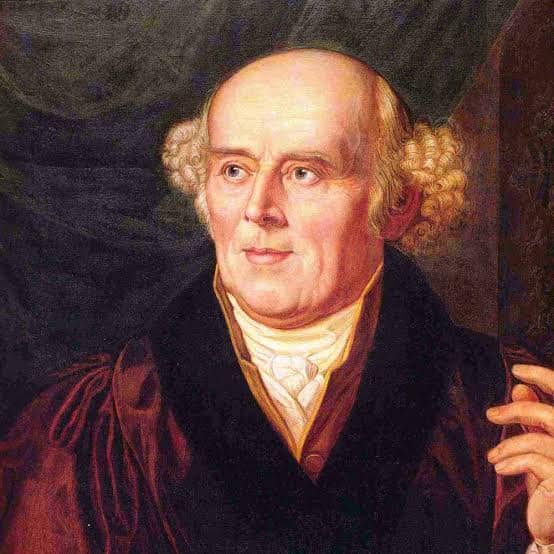
크리스천라이프 편집부
